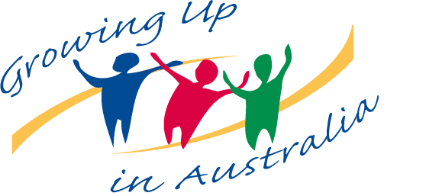Annual statistical report 2017
Annual statistical report 2017

Foreword
I am pleased to introduce the eighth volume of the Annual Statistical Report series for Growing Up in Australia: The Longitudinal Study of Australian Children (LSAC). This report, produced by the Australian Institute of Family Studies, aims to provide valuable insights into family functioning and child development for researchers, policy makers and those who provide services and support, as well as the community at large.
Using six waves of LSAC data, this report discusses ways in which Australian children's experiences and environments affect their prospects and progress, from birth to 15 years old. For the first time in this series, matched data from the Australian Early Development Census (AEDC) is used to investigate differences in children's developmental outcomes at the start of school, depending on the type of early childhood education and care programs they attended at ages 3 and 4.
Children's housing experiences are examined over a 10-year time period, providing new insights about how housing conditions change when parents separate. The chapter on children's use of health care services highlights the differences in the numbers of teenage boys and girls who required medical attention for an injury, with more boys than girls requiring medical attention for breaks, fractures and concussions.
Young people's relationships with their family and friends are a big part of this report, with chapters exploring time adolescents spent with parents and friends as they grow up; their help-seeking behaviours when they face emotional problems; and the quality of attachment and characteristics of their friends.
This report also provides a snapshot of how teenagers are faring in relation to eating problems, the types of actions they take to control their weight and the association between dieting and physical and mental health outcomes.
We hope that the results of our research will prove useful to interested readers. We further hope that the wealth of information provided here will encourage others to use the LSAC data, both now and in the future.
![]()
Anne Hollonds
Director
Australian Institute of Family Studies
Contents
Study purpose and design
2. Key findings from the Annual Statistical Report 2017
A summary of the key findings from each of the topics covered in this report
3. Children’s housing experiences
Diana Warren
This chapter describes the types of housing that the LSAC study children live in, whether their parents own or rent, the condition of their homes and how often they relocate. It also examines the extent to which children experience (short-term or ongoing) housing stress and inadequate housing (e.g. overcrowding, housing in poor condition) and the impact of family separation on housing experiences. For example, single-parent families are more likely to experience longer periods of housing stress than other families.
Media release: Children growing up in families under housing stress
4. Who do adolescents spend their time with?
Jennifer Baxter
This chapter explores who children in the LSAC K cohort spent their time with at ages 10–11, 12–13 and 14–15, based on children’s self-reported time use diaries. These time use patterns are examined for boys and girls by age. Differences in time use according to family structure and parental employment are also explored. These time use patterns provide insights on the lives of adolescents, and highlight circumstances in which adolescents may have more limited opportunities for such time.
5. Relationships between parents and young teens
Maggie Yu and Jennifer Baxter
This chapter describes parent–child relationships at ages 10–11, 12–13 and 14–15 years. The quality of adolescents’ relationships with parents is explored using a number of measures that provide different views on this relationship. These measures include children’s reports of enjoyment in spending time with their parents; their closeness to their mother and father; who they talk to when they have a problem; and parents’ reports of conflict with their children.
6. Adolescents’ relationships with their peers
Sarah Gray, Helena Romaniuk and Galina Daraganova
The purpose of this chapter is to provide a snapshot of the peer relationships of Australian adolescents, by describing peer attachments, peer group attitudes, and peer problems as they are reported by young people in mid-adolescence. In addition, the relationship between adolescents’ peer relationships and bullying is examined. For example, having friends who engaged in more risky behaviours increased the likelihood of being bullied and of also being a bully.
Media release: Strong peer group helps keep bullies at bay
Sarah Gray and Galina Daraganova
Understanding who adolescents go to for help for their personal and emotional problems is important to inform appropriate pathways of care. This chapter describes the past help-seeking behaviours and future help-seeking intentions of adolescents, focusing on who adolescents go to for help. The help-seeking behaviours and intentions of adolescents who are experiencing symptoms of mental health difficulties are compared with those of adolescents with no symptoms of mental health difficulties.
Media release: Most teenagers turn to parents and friends for help
8. Preschool and children’s readiness for school
Diana Warren, Galina Daraganova and Meredith O’Connor
Helping children to thrive at school requires supporting their development well before they enter the school setting. One way to promote learning and social-emotional development before children start school is through attendance at preschool. This chapter explores the relationship between attendance at early childhood education and care at ages three and four and children’s developmental outcomes when they start school, using data linked to LSAC from the Australian Early Development Census (AEDC).
9. Kids’ care and activities before and after school
Pilar Rioseco, Jennifer Baxter and Diana Warren
Working parents often have to juggle family and work responsibilities, including organising different types of care for their children while they are at work. This chapter explores parents’ use of formal and informal care before or after school and how this varies according to children’s age and family and school characteristics. We also explore children’s participation in extracurricular activities provided by the school and other organisations. For some families these may be a substitute for outside-school-hours care.
10. Use of technology in the classroom
Suzanne Vassallo and Diana Warren
Using data collected between 2006 and 2014, this chapter provides a description of the types of activities that educational technology is used for in primary and secondary school classrooms, and how often ICT is used. Teachers’ views about technology use in the classroom, and the extent to which teachers’ views and use of technology differ according to teacher and school characteristics are also explored.
11. Eating problems in mid-adolescence
Meredith O’Connor, Diana Warren and Galina Daraganova
Many eating problems develop in adolescence, so intervening early, by promoting healthy eating and nutrition, when unhealthy eating behaviours start to arise is crucial for long-term health outcomes. The purpose of this chapter is to provide a ‘snapshot’ of how young people are faring in relation to eating problems at 14–15 years of age, the types of actions they take to control their weight and the association between those actions, particularly restrictive dieting, and physical and mental health outcomes.
Media release: Dieting a weight on teenage minds
12. Children’s use of health care
Diana Warren
This chapter uses data collected between 2004 and 2014 to provide a snapshot of how health care services are used; problems gaining access to health services; and how children’s use of health services differs depending on characteristics such as household income, parental education, private health insurance coverage, location and parents’ reports of the general health of the child.
Media release: Concussion rates a concern for teenage boys.
The technical appendix provides details on the LSAC sample, respondents and collection methods, sampling and survey design and details of the weights supplied in the data to correct for non-response and attrition.
Authors and Acknowledgements
We gratefully acknowledge the enormous contribution of the young people, their parents and teachers who have participated in the study.
The Australian Institute of Family Studies thanks the Australian Government Department of Social Services (DSS) for funding this report, and the DSS LSAC team for their feedback on earlier drafts of this report.
We also wish to acknowledge the valuable contributions of the AIFS Survey and Data Management team, the LSAC Consortium Advisory Group, the LSAC team at the Australian Bureau of Statistics and the LSAC interviewers.
For more information about the study, see the LSAC website.
This report uses unit record data from Growing Up in Australia: The Longitudinal Study of Australian Children. The study is conducted in partnership with the Australian Institute of Family Studies, with advice being provided by a consortium of leading researchers at research institutions and universities throughout Australia. The Australian Bureau of Statistics (ABS) conducts the data collection.
This report has been compiled and written by staff at the Australian Institute of Family Studies. The views expressed in this report are those of the individual authors and should not reflect those of DSS, AIFS or the ABS.
Featured image: © iStock-monkeybusinessimages










